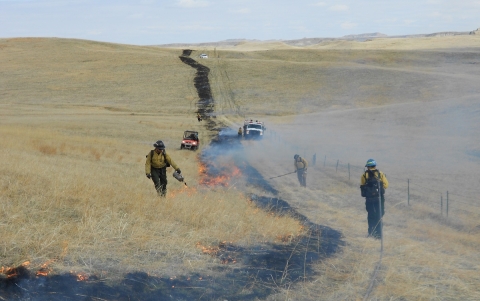Visit Us
Recreational activities such as wildlife observation, photography, hiking, cross-country skiing, and upland bird and waterfowl hunting can be enjoyed on the Refuge. A 15-mile self-guided auto tour route takes you around Lake Bowdoin where you will see a variety of habitats. Near the visitor center is a 0.4-mile, accessible trail that loops around Display Pond.
The Refuge headquarters and visitor center is open your-round, Monday through Friday from 7:30 a.m. to 4:00 p.m., except Federal holidays. The headquarters' entryway is always open and provides visitors with a touch table of exciting wildlife items, brochures, and restrooms.
Location and Contact Information
- Bowdoin National Wildlife RefugeView Details194 Bowdoin Auto Tour Road Malta, MT 59538-9617
About Us
Lake Bowdoin is a remnant of the pre-glacial era from when the Missouri River flowed this far north. The lake is a former oxbow, and it is now a central part of Bowdoin National Wildlife Refuge. Along with the other wetlands in the area, this prime habitat lies within the Central Flyway, a great waterfowl migration corridor that stretches between Canada and Mexico. Tens of thousands of birds pass north toward breeding grounds in the spring and south to wintering grounds in the fall. Large concentrations of birds remain here in the summer to breed, as ideal nesting habitat is abundant due to the combination of native prairie grasslands and wetlands.
What We Do
Some of the goals of the Bowdoin National Wildlife Refuge are to protect, enhance, and restore grassland habitat for breeding and migratory birds and other wildlife while maintaining the biological diversity and integrity of native prairie grasslands. Also, to provide, protect, and manage wetland habitat for breeding and migratory birds and other wildlife that maintains the biological diversity and integrity of prairie pothole wetlands. To help plants and wildlife, refuge staff use a variety of habitat management techniques to maintain, recover or enhance plant and wildlife values.
Our Species
Just as the cottonwood trees found around Display Pond change with the seasons, so do the wildlife species that are found on the Refuge. The spring season comes alive with Canada geese, mallards, and northern pintails arriving first, with flocks of other waterfowl following and continuing north. Grassland songbirds such as western meadowlarks are among the first to arrive on the prairie. In April, sharp-tailed grouse display on their dancing grounds, known as leks, giving quite a display.
The native prairie grasslands are filled with song as Sprague's pipit, Baird's sparrow, and chestnut-collared longspur all defend territories for nesting in early summer. Summer provides the opportunity to observe a variety of species in different habitats. Nesting ducks, like northern shovelers, can be seen in the prairies, and others, such as redheads, can be spotted around the water.
Colonial nesting birds can be seen staking out their nesting territories on islands in Lake Bowdoin. White-faced ibis and eared grebes search for emergent vegetation, such as bulrush, to create floating nests to raise their young. Many shorebirds migrate through this area, with American avocets, Wilson's phalaropes, and willets staying to nest on wetland shorelines. If you are lucky, you may see pronghorns grazing on sagebrush sagebrush
The western United States’ sagebrush country encompasses over 175 million acres of public and private lands. The sagebrush landscape provides many benefits to our rural economies and communities, and it serves as crucial habitat for a diversity of wildlife, including the iconic greater sage-grouse and over 350 other species.
Learn more about sagebrush , or even a coyote on the hunt.
Late July brings the first sign of fall, with the migration of the smallest of sanpipers, known as "peeps". The true fall migration starts in early September and continues until the wetlands are covered fully in ice, typically in mid-November.
During that stretch of time, flocks of marbled godwits, dowitchers, yellowlegs, yellow-headed and red-winged blackbirds, eared grebes, and various waterfowl, including tundra swans, form large groups before moving southward. You might spot a young peregrine falcon or bald eagle that comes to take advantage of the concentrations of birds to learn how to hunt.
Sandhill crane flocks often fly overhead, some landing to rest overnight and then continue south.
Winter is the quiet time of year. Sharp-tailed grouse flock up on the Refuge after the first snowfall. Rough-legged hawks, often seen perched on power poles and fence posts, use this area for their wintering grounds. Snowy owls which migrate down from the Arctic tundra, can be seen sitting on the ground, camouflaged in with the wind swept snow of the prairie. Black-billed magpies, American robins, and American tree sparrows provide some bird song on an otherwise quiet day.
The break up of the ice on Lake Bowdoin, typically during mid-March, releases winter back to spring. The first ducks come, along with bald eagles looking for an easy meal. The seasons of wildlife circle back again.













